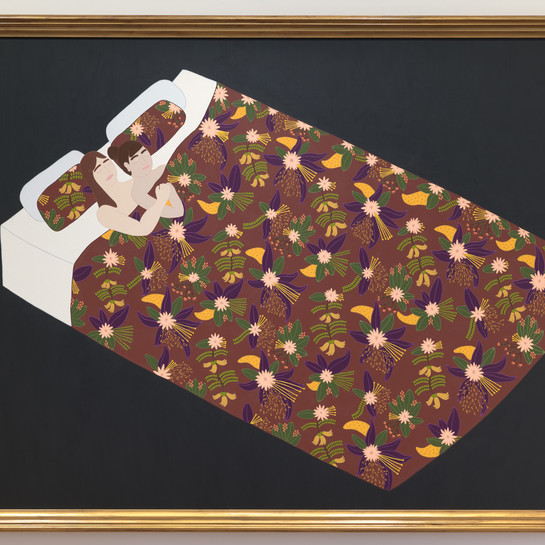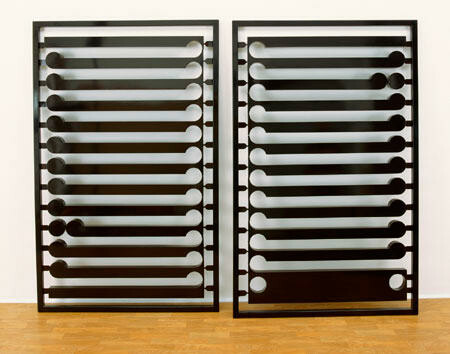Michael Parekowhai
Aotearoa New Zealand, b.1968
Ngā Ariki Rotoawe,
Ngāti Whakarongo,
Māori
Kiss The Baby Good-Bye (the maquette)
- 1997
- Black enamel on steel
- Purchased, 1997
- 1905 x 1193 x 39mm
- 97/40.1-2
Tags: abstraction, appropriation (imagery), colonization, gates, koru (pattern), Māori (culture or style), model-making, pairs, toys (recreational artifacts)
During the 1990s, Michael Parekowhai began reworking familiar objects as art. They were intended to be understood in several ways at once, opening up conversations around colonialism and cultural appropriation – the use of indigenous cultural material by non-indigenous people – in art. Gordon Walters’ appropriation of the pītau (fern frond) motif from Māori kōwhaiwhai painting has generated heated criticism and debate. Parekowhai’s witty response pays homage to Walters while reclaiming the pītau. By adding two circles to Walters’ composition, Parekowhai suggests a full stop to the matter.
(Te Wheke: Pathways Across Oceania, 2021)
Exhibition History
Appropriation—specifically, the use of indigenous cultural material by non-indigenous artists—was one of the critical issues of 1990s art in New Zealand, mirroring the other arguments about Māori land and property rights that were being waged in wider society. Michael Parekowhai’s monumental work Kiss the Baby Goodbye made a major contribution to that heated debate, when he reworked Gordon Walters’ painting Kahukura, completed in 1968—the year of Parekowhai’s own birth—as a sculpture in three dimensions, a giant kitset model ready to be snapped out and made up.
In the late 1980s and early 90s, Walters had been both vigorously attacked and fiercely defended for his earlier use of the pītau (fern frond) design taken from kōwhaiwhai panels in wharenui. Parekowhai’s Kiss the Baby Goodbye was an adaptation of Walters’ painting that both acknowledged the older artist’s work and asserted Māori ownership of its significant forms. It also brought the pītau design back from two dimensions into architectural space.
Christchurch Art Gallery’s work is a smaller version of Parekowhai’s original, made for his first major solo exhibition in 1994. Both sculptures share something not included in Walters’ painting: a final circle at the bottom right corner, which appears like a full stop. Parekowhai, it seemed, would have the last word.
(Your Hotel Brain 13 May 2017 - 8 July 2018)
In the 1960s Pākehā (European) New Zealand artist Gordon Walters (1919 -1995) painted a series of modernist works based on the traditional Māori koru (fern motif). They became the focus of a vigorous debate regarding issues of cultural intellectual property rights. Michael Parekowhai's work mimics Walters' painting Kahukura (1969), and so re-appropriates Walters' appropriation of the koru form. Kiss The Baby Goodbye dissects the Walters koru into two steel halves that lean against a wall. The black spray painted steel is like a giant model kitset, with the snap out components still intact.
Born in Auckland, Parekowhai received a Bachelor of Fine Arts from the University of Auckland in 1990. He also has a Diploma in Teaching. Parekowhai has exhibited widely in both group and solo exhibitions and has received numerous grants from the Queen Elizabeth II Arts Council. He currently lives and works in Auckland where he lectures in sculpture at Elam School of Fine Arts, University of Auckland.


